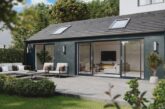
When choosing windows and doors for their property, homeowners are often polarised by the choice of material for the frames.
The choice for original and replacement window and door frames is timber, PVC-U and aluminium in all but listed and conservation-area properties. Each material has its pluses and minuses but whatever the choice, it’s very difficult to buy a duff window these days, as long as you choose a reputable supplier.
Things have changed a great deal in the past decade to put paid to some of the old tropes about window frames. Whilst cheap original timber frames installed in estates homes thirty plus years ago helped to create the market for replacements, first by aluminium and then by PVC-U (or u-PVC as it was then), the timber industry responded (eventually!) and timber frames from a reputable source will now give many years of service and performance.
Similarly, although aluminium was squeezed out by the ubiquitous white PVC-U frames back in the Seventies, around five years ago aluminium windows and doors made a storming comeback, led by the aluminium-framed bi-folding doors featured on the many architectural shows on television.
Faced with the revival of both timber and aluminium, the PVC-U industry also pulled its collective socks up with the offer of subtle coloured and textured frame finishes and the ability to emulate any architectural style.
So how do you choose?
Timber is often the only choice, coupled with strict curbs on the style of window, in listed buildings or those in conservation areas. As such they are often expensive and supplied by specialist manufacturers. But for general new build or refurbishment, timber windows may now be regarded as being on a par with anything manufactured in aluminium or PVC-U and are still regarded by many as more appropriate for upmarket properties. In terms of maintenance, timber windows will require more looking after than their metal and plastic equivalents but should still put in many years between re-staining or painting.
![]()
Timber still commands a very small and select corner of the overall market however, with the remainder fought over by aluminium and PVC-U. Both materials are light years ahead of where they were, with the (frankly horrible) anodised aluminium windows and bright, white (obviously plastic) PVC-U casements thankfully well behind us.
The key advances in PVC-U framing include the style of frames that can be produced, including the now highly sought after ‘flush sash’, and coloured and textured surface finishes. These developments alone have combined to disguise that the frames are plastic, and with other subtle design changes PVC-U windows and doors may be blended seamlessly into most architectural styles. Even vertical sliding box sash frames can be manufactured to offer highly convincing authenticity, a huge boost for the owners of properties of all ages defined with this style.
Aluminium has received an amazing comeback in recent years and, from being something that was often only installed in sliding doors, there is a huge choice of residential window and door styles now available. Generally, aluminium allows the manufacture of frames with slimmer profiles and are often specified to compliment a bi-folding or sliding doors installed in a home.
Thermal performance and maintenance attributes are on a par with PVC-U, although the latter will usually undercut ‘ali’ on price.
As always, pick your supplier carefully and you won’t go wrong.







